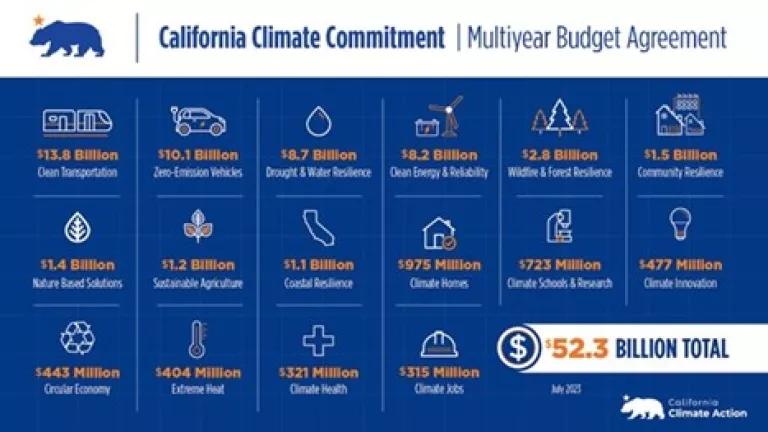
California’s policy makers have had a jam-packed week, passing a massive budget that included $53.9 billion in new investments to protect Californians from extreme weather and to address climate change, and a 60-page energy trailer bill with detailed policies and programs, some of which were only revealed days before the final vote.
It is important to note that while the budget was approved and many new policies were created when the Governor signed the budget yesterday, some of the spending details were deferred until the legislature returns from summer recess in August. The $53.9 billion in climate-related investments includes $19.3 billion in the Climate-Energy Package. The “buckets” within this package have been agreed to, but not much of the detail has been fleshed out. For example, this includes $8 billion for energy, $300 million for extreme heat adaptation, $2.7 billion for drought response and resilience, and the alluring $3 billion “flexible climate set-aside” that is sure to spark lively debate during the final month of the legislative session.
However, much was decided this week and many of the juicy energy-related details are in the energy trailer bill, including:
· Debt relief for utility customers – Building on the $1 billion in energy bill debt relief from last year, this budget adds $1.2 billion that will be focused on customers at risk of disconnection due to past due energy bills.
· Income-based charges for energy – The bill enables (and requires by July 2024) the California Public Utilities Commission to oversee changes to residential rates that will charge customers for fixed system costs, like the poles and wires to deliver electricity, based on their ability to pay. This will more equitably distribute shared energy system costs and reduce the price of each kilowatt hour used by a customer, making it more attractive to use clean electricity to power cars and heating systems. The language explicitly requires that energy charges not impair “beneficial electrification and greenhouse gas emissions reduction” and that low income customers must “realize a lower average monthly bill without making any changes in usage.”
· Long duration energy storage – A California Energy Commission (CEC) program to allocate $140 million for long duration energy storage projects that provide capacity and grid support.
· Certification of clean energy generation and storage facilities – The bill creates a new streamlined certification process at the CEC for solar, wind, or thermal powerplants that do not use fossil or nuclear fuels (aka geothermal), and for energy storage systems, production facilities, and transmission lines from those generating or storage facilities. While this new certification process is not perfect, the final language was responsive to amendments requested from stakeholders.
· Strategic Reliability Reserve – An initial investment of almost $3 billion (possibly more to come in August) that is intended to firm up California’s energy supply and avoid outages. This includes two CEC programs – Demand Side Grid Support ($200 million) and Distributed Electricity Backup Assets ($550 million) – and Department of Water Resources (DWR) reliability investments ($2.2 billion). However, a significant portion of the language pertaining to DWR investments was not shared until it was too late to review and make changes. While NRDC agrees that the state should be taking action to address reliability over the next several years, we view this portion of the energy trailer bill as rushed, unvetted and fossil-fuel heavy, prompting our opposition letter. While the Governor signed the bill into law last night, he also sent this signing message to the Assembly which makes a number of commitments about the intentions and impacts of this bill. NRDC looks forward to working with the Governor and legislature to make improvements to the Strategic Reliability Reserve this fall.
In short, a lot happened this week and the budget is far from over with the details of so many investments yet to be nailed down. The climate investment of $53.9 billion is a huge boost during a week when those of us who care about the environment and protecting communities from climate change impacts have suffered a barrage of bad news. Let’s recommit to making the rest of the budget money really count as we head into the end of the legislative session.




